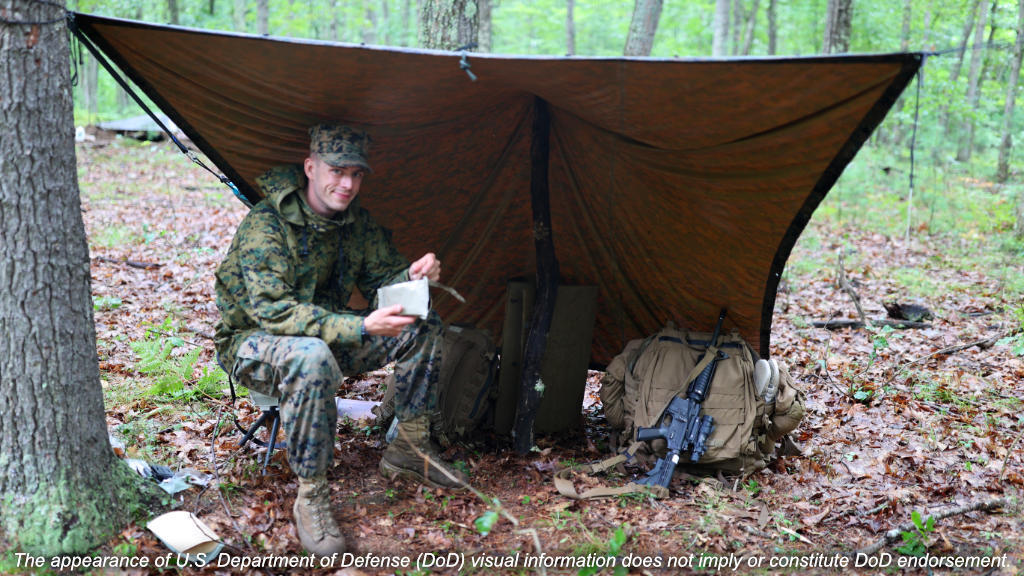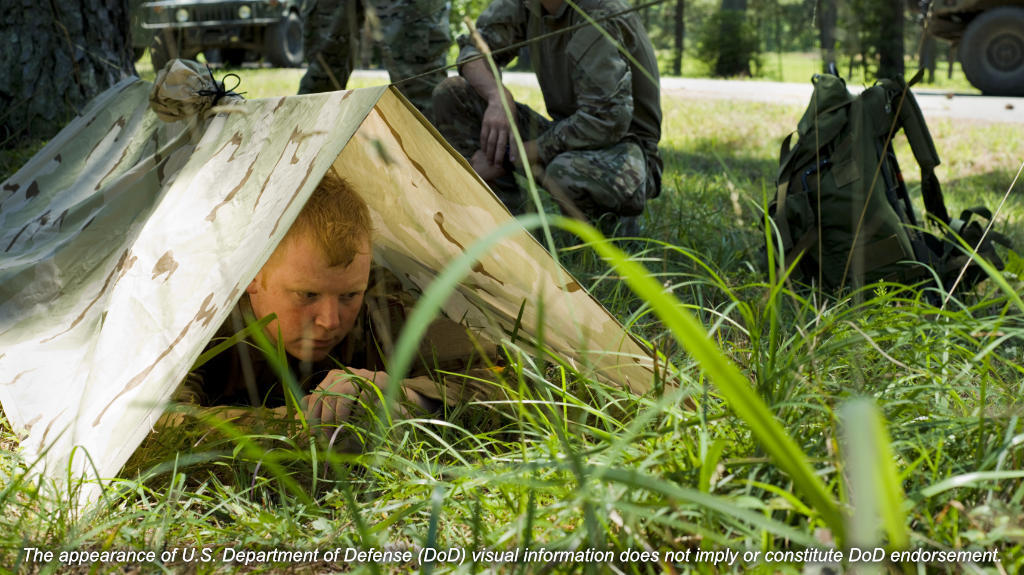Unlock the Versatility of the US Army Poncho
Posted by Surplus Squad on May 9th 2025
Did you know that a single US Army Poncho could potentially save a soldier’s life by serving as emergency shelter in harshest elements? This unconventional fact underscores the multifaceted utility of this remarkable piece of gear. As you explore the many roles of the military poncho, from a rain poncho to an essential survival tool, you’ll be drawn into its world of durability and unmatched functionality.
The US Army Poncho: A Legacy of Durability and Functionality
Understanding the US Army Poncho
The US Army Poncho is a product of decades of military innovation aimed at creating an all-purpose piece of rain gear. Unlike traditional rain ponchos, the military poncho is crafted to resist a variety of adverse weather conditions, keeping troops dry and agile in operations. Its design integrates functionality and resilience, using materials that ensure longevity and reliability, such as ripstop nylon.
Historical Significance of the Military Poncho
The military poncho’s origins trace back to a need for durable, multi-functional gear for soldiers. It was not merely a rain poncho but a symbol of adaptability and resourcefulness in the field. Through wars and peacekeeping missions, its design has evolved, yet it remains a staple in military attire, highlighting a legacy of practicality and innovation.
Features of the US Army Poncho
Waterproof Ripstop Nylon: The Backbone of US Army Poncho Resilience
Ripstop nylon is the foundation of the US Army Poncho’s legendary toughness. Engineered with a distinctive crosshatch weave, this lightweight material is designed to stop small tears from spreading, ensuring the poncho remains reliable even under the harshest field conditions. Typically weighing just 1.6 ounces per square yard, the ripstop nylon used in Army ponchos is treated with a polyurethane waterproof coating, making it fully weatherproof while remaining breathable and comfortable to wear.
This military-grade fabric is not only tear-resistant but also minimizes noise — an essential feature for tactical operations. Its durability allows the poncho to withstand heavy use, rough terrain, and repeated packing without losing integrity. Whether you’re facing a downpour or using it as an emergency shelter, ripstop nylon is the unsung hero that delivers the perfect balance of strength, versatility, and comfort in every US Army Poncho.

Multi-Functional Use in Wet Weather
The US Army Poncho excels in wet weather, designed to keep wearers dry in torrential rains thanks to its waterproof polyurethane coating and generous coverage that easily fits over uniforms and gear. More than just a rain poncho, it can be quickly transformed into an emergency shelter or ground cover using the integrated metal grommets along its edges. When paired with a poncho liner — often called a “woobie” — it becomes a lightweight sleeping bag or insulated blanket, offering warmth and protection in cold, damp conditions. This remarkable versatility makes the US Army Poncho an invaluable asset for soldiers and outdoor enthusiasts alike, adapting seamlessly to any survival or camping scenario.Integrated Features for Survival Situations
Beyond wet weather protection, the US Army Poncho is packed with features that support survival in varied environments. Heavy-duty side snaps allow it to be securely fastened or joined with other ponchos to create larger shelters. The perimeter grommets make it easy to tie down as a tarp, sun canopy, or even a field-expedient stretcher. Its lightweight, compact design ensures it can be carried effortlessly without adding bulk to a soldier’s or camper’s pack. Whether used for concealment, water collection, or as a quick shelter in the field, the US Army Poncho’s thoughtful design and multi-use functionality make it indispensable in any situation.
Comparative Analysis: US Army Poncho vs. Standard Rain Poncho
Material Composition and Style Comparison
When compared to standard rain ponchos, the US Army Poncho stands out with its superior ripstop nylon construction. Typical rain ponchos often use basic nylon or polyester, which may offer insufficient durability. The military version not only improves resilience but also incorporates a more practical design for tactical use.
Adaptability in Different Weather Conditions
The US Army Poncho is crafted to adapt to a variety of weather conditions, unlike most standard options. Whether it’s heavy rain, wind, or unexpectedly cold temperatures, this poncho’s design ensures that users remain protected and comfortable. Its light weight and compact nature further enhance its adaptability, allowing it to serve multiple purposes as needed.Comparative User Reviews and Ratings
Users often provide glowing reviews for the military poncho, noting its efficiency and robust performance in challenging conditions. Compared to standard rain gear, its star rating reflects a high level of satisfaction, particularly praised for its versatility and quality construction, making it a preferred choice for outdoor enthusiasts.

Customer Feedback and Reviews
General Customer Reviews
The consensus among general users is that the US Army Poncho offers unparalleled versatility and durability. Many customers find the poncho’s build to be exceptionally durable, offering peace of mind with its easy setup and lightweight quality. These aspects alone garner it a high star rating.
In Praise of the Poncho
Feedback from military personnel often highlights the poncho’s reliability in critical situations. Soldiers have found the poncho not only practical but life-saving when used as an emergency resource. This trust placed by those in service underscores its value and validity in military applications.
“Everybody loves the poncho liner. It’s a given. But what about the poncho? It kept me dry on patrols. Even my pants. If I teamed up with a buddy, we could use them to make a hooch to sleep in. I put it over my gear and it kept it dry in torrential downpours. I love you, poncho. I’m sorry your younger brother stole the limelight.”
People Also Ask
What poncho does the US military use?
The US military primarily uses a specialized US Army Poncho known for its durability and functionality. It is designed from ripstop nylon to withstand harsh weather and demanding conditions.
Does the army still issue poncho liners?
Yes, poncho liners are still issued to provide additional warmth and are often used in conjunction with the army poncho to form a makeshift sleeping system.
What size is a US military poncho?
The standard size of a US military poncho is approximately 92″ x 66″ or 87″ x 62″ depending on model, offering ample coverage for various uses including as an emergency shelter.
What are ponchos called now?
Ponchos for civilian use may be referred to as simply ‘ponchos’ or specifically as ‘style ponchos’ or ‘rain ponchos’ depending on their design and intended use. Military ponchos are called ‘Wet Weather Ponchos’ as they were specifically designed to keep soldiers dry in rainy weather.
What is a poncho liner?
A poncho liner is a lightweight, quilted blanket designed to be used with a military poncho, providing extra warmth and comfort as a makeshift sleeping bag or blanket. Also known as a ‘woobie’, it is not part of the poncho but can be purchased separately for even more functionality.

Inspiration: How the US Military Uses Army Ponchos
Military ponchos are renowned for their versatility, especially in survival, tactical, and outdoor contexts. Here is a comprehensive list of uses for a military poncho:
Shelter and Weather Protection
- Rain Protection: The primary use is as a rain garment, shielding the wearer from rain and snow.
- Improvised Shelter: Can be pitched as a tarp or tent using paracord, trekking poles, or branches, providing protection from sun, wind, and rain. Multiple ponchos can be combined to shelter multiple people.
- Emergency Bivouac: Functions as an emergency sleeping shelter or bivy sack.
- Ground Cover: Used as a moisture barrier or ground tarp to keep you and your gear dry.
- Windbreaker: Acts as a barrier against strong winds.
- Sunshade: Provides shade in hot, sunny environments.
Survival and Field Uses
- Sleeping Bag/Bivvy Cover: When combined with a poncho liner (“woobie”), it can serve as a sleeping bag or insulated cover for cold weather.
- Blanket: Used as an emergency blanket for warmth.
- Stretcher/Litter: Can be fashioned into a stretcher for casualty evacuation with the help of poles or sticks.
- Hammock: With proper setup, can be used as a makeshift hammock.
- Raft/Floatation Aid: With some work, can be used as a temporary ruck raft or flotation device.
- Improvised Bag: Used to collect and carry natural materials or as a makeshift gear bag.
- Water Collector/Carrier: Can collect rainwater or carry water over short distances.
- Fish Net: Can be adapted into a simple fish net in survival situations.
- Shower Nozzle: Used to create a makeshift shower by directing water flow.
- Heat Reflector: Positioned near a fire to reflect heat into a shelter.
- Smoke Signal Tool: Used to signal for help by directing smoke or as a visual distress signal.
- Sail: Can be rigged as a small sail for improvised watercraft.

Tactical and Camouflage Applications
- Camo Screen/Visual Cover: Breaks up the human silhouette and can be used as camouflage for hiding personnel or equipment.
- Cover for Gear/Weapons: Protects backpacks, weapons, and sensitive equipment from the elements.
- Foxhole/Machine Gun Cover: Used to cover defensive positions or equipment.
Comfort and Convenience
- Insulated Layer: When paired with a poncho liner, provides extra warmth as an insulated garment or sleeping system.
- Field Expedient Pillow: Poncho liner can be rolled up as a pillow.
- Easy Layering: Loose fit allows for layering over bulky clothing or gear.
- Quick Access to Gear: Worn over body armor or load-bearing equipment, still allows access to pouches.
- Quick On/Off Over Backpack: Can be thrown over yourself and your pack without removing gear if rain starts suddenly.
Additional Uses
- Waterproof Suit: Snapped closed at the sides, it can serve as a full-body waterproof suit.
- Decoy: Used as a decoy or distraction tool in certain tactical situations.
- Improvised Bag for Natural Materials: Useful for gathering firewood or shelter-building materials.
Military ponchos are favored because they are lightweight, packable, and multifunctional — qualities that make them indispensable for soldiers, survivalists, and outdoor enthusiasts alike.
Why Choose the US Army Poncho?
Opt for the US Army Poncho for its time-tested durability, unmatched multi-functionality, and reliable performance in the toughest conditions.
Explore the US Army Wet Weather ACU Poncho here
View all our military ponchos here
US Army Wet Weather ACU Poncho
Blackie Thomas has some great tips on using the US Army poncho in this video. It’s only the tip of the iceberg but you’ll still get to witness some of its adaptability in real-world settings.

